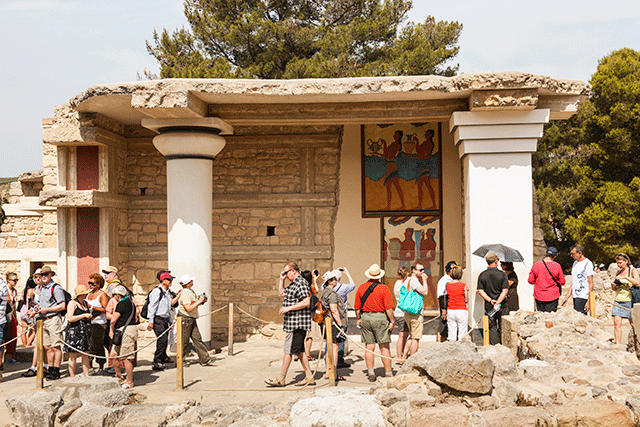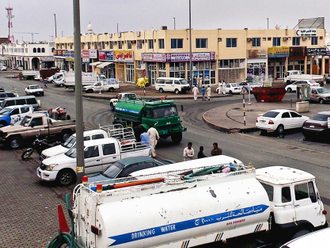
Greek tragedy
Snow still clings to the peaks of the White Mountains in western Crete at this time of year. The air is chilly, but the sun is already warm, and foothills that will soon be arid and brown are covered with scarlet, yellow and wild flowers. Citrus groves are heavy with lemons and oranges.
But in May 1941, this tranquil countryside was far from peaceful. In the mountain village of Askifou, Andrew Hatzidakis presides over the Askifou War Museum, a vast collection of Second World War militaria — relics of the tragic Battle of Crete, when thousands of defeated Commonwealth and Greek troops trudged across the mountains of Crete under constant German air attack. Around 16,000 of them were evacuated from the little harbour at Hora Sfakion, on Crete’s south coast. German casualties were heavy, as you can see by visiting the German military cemetery near Maleme. The allied dead lie in the Commonwealth cemetery at Souda, just outside Chania.
Liberated in 1945, Crete has been at peace ever since. But there are reminders of a long and turbulent history all over Greece’s largest island. Visit Knossos, the most impressive of the ancient Minoan palaces rediscovered by archaeologists in the last century, for a taste of Europe’s first civilisation. The Heraklion Archaeological Museum is a treasury of finds from millennia-old Minoan sites all over the island.
At Gortyn, in southern Crete, toppled columns and the remains of pagan temples and Crete’s first Christian basilica are reminders of the Roman era, while medieval strongholds such as the Fortezza, which overlooks the pretty harbour at Rethymnon, are reminders of Venetian rule.
Getting there: Aegean Airlines (www.aegeanairlines.com) flies from Athens to Chania and Rethymnon.
The longest way
Seventy years after British paratroopers fired the first shots of the D-Day offensive in a small village called Bénouville, the café where owners Georges and Thérèse Gondrée welcomed them with champagne is still called the Pegasus Café and their objective — a strategic bridge crossing the Caen Canal — is known as Pegasus Bridge. Both are named for the flying-horse badge of the 6th Airborne, whose glider-borne troops landed here just 16 minutes after midnight on June 6 — the first Allied troops to set foot in France since 1940.
Replaced in 1994, the original bridge is now the centrepiece of the excellent Memorial Pegasus museum, along with uniforms, weaponry, vehicles and a replica of the Horsa glider used in the operation. To put the operation in context, go to the nearby D-Day Museum at Arromanches. And for a reminder of a much earlier invasion, visit the Bayeux Tapestry Museum, where an amazing 69-metre 11th-century work of art depicts the Norman conquest of England.
Getting there: Bénouville is 10km from Caen. The train from Paris to Caen takes just under two hours.
Visit: Memorial Pegasus (www.memorial-pegasus.org), D-Day Museum (www.arromanches-museum.com) and Bayeux Tapestry (www.tapisserie-bayeux.fr)
The final offensive
The new Bastogne War Museum, in the Belgian Ardennes, uses multi-sensory immersive dioramas to put the Battle of the Bulge in context, with eyewitness accounts from the point of view of German and American soldiers as well as Belgian civilians.
On December 16, 1944, the Wehrmacht launched its last shot at stopping the Allied advance on Germany’s borders.
Field Marshal Walter Model’s panzers took the Americans completely by surprise, advancing 80km in just three days. Thick cloud and heavy snow helped the Germans, depriving the beleaguered US troops of air support. Bastogne — a vital transport hub — had to be held. Outnumbered more than two to one, the US 101st and 82nd Airborne held out for almost a month until reinforcements arrived.
The museum tells it like it was, and there’s more to see around Bastogne. Elsewhere in the Ardennes, you can go kayaking or canoeing in beautiful river valleys, walk or cycle for miles through thick forests. Medieval castles seem to crown every hilltop, and those at Namur, Bouillon and Dinant are truly impressive.
Getting there: Bastogne is 150km (two hours’ drive) east of Brussels.
Desert victory
Outside the Al Alamein War Museum, ranks of British and German tanks, armoured cars and artillery are mementos of a decisive battle that Winston Churchill hailed as the end of the beginning of Second World War.
A year after defeat in Crete, Marshal Erwin Rommel’s Afrika Korps seemed poised to sweep the British out of Egypt. But in July 1942, the German advance stalled just a couple of hours’ drive from Alexandria. Four months later, the Allies hit back.
On October 23, German forces that dug in at Al Alamein were wakened by massed artillery fire. The battle lasted for 11 days, but on November 4, the defeated Germans withdrew. Pursued across the Western Desert, the Afrika Korps made a last stand in Tunisia before laying down its arms in May 1943. Today, the dunes and rocky ridges where the battle took place are empty and silent, and it’s hard to imagine that 80,000 men died here. But a visit to one of Al Alamein’s war cemeteries, with their endless ranks of tombstones is a powerful reality check.
After paying your respects to those who fell at Al Alamein, it’s worth taking in some of the sights and museums in Alexandria. The ancient city’s newest attraction is the magnificent Bibliotheca Alexandrina, a superb piece of 21st-century architecture. Don’t miss the spooky Kom Al Shouqafa Catacombs, the impressive Roman amphitheatre, or the elegant Abu Abbas Al Mursi mosque.
Getting there: Al Alamein is about 100km west of Alexandria and 180km north west of Cairo.
The real Guns of Navarone
Leros, in the eastern Aegean Sea, offers some of the best wreck-diving in Greece. Rusting warships, aircraft and anti-submarine nets lie in clear water close inshore — the wreckage of a little-known battle.
Leros and its neighbours, Kos, Samos, and Kalymnos, are popular holiday islands now, with sandy beaches and resort hotels, but in the autumn of 1943 there was fierce fighting here. In the wake of Italy’s surrender, British troops tried to seize these Italian-occupied islands. The German response was immediate and fierce. Massive air attacks forced the British and Italian troops on Leros and Kos to surrender. Soon after, Royal Navy destroyers evacuated the last British troops from Samos, in an operation that inspired the book and film The Guns of Navarone.
Leros was Italy’s key naval base on the islands, and the harbour is lined with grandiose fascist art deco buildings that once housed the fleet headquarters. Artillery bunkers and tunnels are scattered around the island, but the main attraction for divers is the wreck of the Greek destroyer Vasilissa Olga.
Onshore, you can visit a unique war museum, housed in a wartime tunnel, and a handful of other quirky small museums. For a taste of classical Greece and the Roman empire, visit the fourth-century BC Asklepion, ancient agora and Roman Odeon on neighbouring Kos, or the ruins of the Ireon (temple of Hera) on Samos. To get your adrenaline pumping, Kalymnos has the most spectacular rock climbing in Greece.
Getting there: Aegean Airlines flies from Athens to Samos and Kos. For ferry connections and bookings, see www.gtp.gr
Visit: Leros Active (www.lerosactive.com) offers three and four-day dive packages including dives to the Vasilissa Olga and other wrecks and visits to Second World War bunkers and fortifications.










